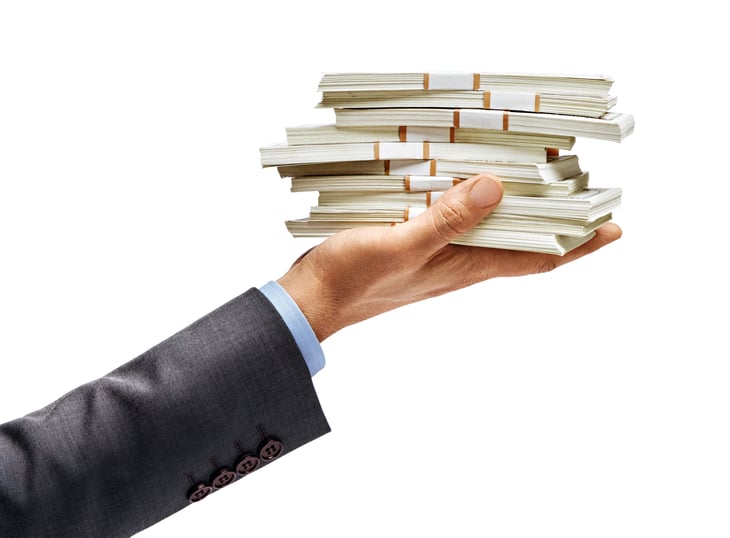
Editor's Note: This story comes from Wealthramp.
You or someone you may know will more than likely experience a windfall event at some point throughout your life.
A massive transfer of wealth is predicted to take place in the U.S. over the next 25 years, according to a recent study by Cerulli Associates.
And while coming into a large chunk of “wealth” wouldn’t necessarily be a “bad” thing, a sudden influx of money is bound to have a significant impact on your life and financial goals.
The best thing that you can do is to plan for a windfall before it occurs so you can be prepared when it happens.
Let’s examine some of the challenges I’ve witnessed some of my clients overcome and dive into some of the best practices you should consider if you come into a financial liquidity event.
Avoid These Mistakes

When it comes to people who unexpectedly experience a windfall or other liquidity event, there are typically two main issues that I see occur.
The first is someone gets more money than they’re accustomed to having, and they get the urge to just go and start spending it. Maybe they buy a new house, a new car, or they want to go on a big vacation.
As an adviser and someone who has built a close relationship with my clients, I want my clients to enjoy their money and spend their money however they feel is right. It’s their money at the end of the day, but I think it’s extremely important that you do some planning first to see how much extra money you have for large purchases.
The second thing I see is the person becoming too conservative, especially with some of the older generations who remember when dividends on stocks and bond yields were much higher.
Oftentimes they want to replace their income completely with dividends and/or income from their investment portfolio, but oftentimes that’s not possible or prudent given inflation and a long time horizon, and that’s when we start helping them with more of a total return approach and education on alternative strategies.
Take My Advice

The best advice that I can give when it comes to people that have come into a liquidity event is that you need to plan and be prepared.
Now that’s easier said than done as there’s a lot of different steps to successfully planning. The first thing you really need to do is to figure out how much cash flow you’re going to spend.
Whether you’re still working, or retired, it’s the basis for proper portfolio management.
If you’re working, you might still just need some additional cash flow to live the life that you would like to live. From there you can put together an investment policy statement that leads to an asset allocation.
If the client is fortunate enough where they’re able to replace all of their income and/or all their cash flow from dividends for bond yields, that’s fantastic. However, that doesn’t tend to be the case.
You’re going to have some form of a total return or what we would call bucket management, which will include ongoing management of those assets. Maybe not daily oversight, but pretty close to it.
Bucket Management

When I first start speaking and working with a client, they’re usually in their savings mode. So at this point we are typically a little more aggressive with our investment strategy because we’re looking to not only keep up with inflation but grow the asset well beyond that.
But I’ll add that it really depends on the risk tolerances of the client at the end of the day.
When it comes to the cash flow aspect, especially when they’re fully retired, you almost look at an individual as if they’re a foundation or institution, who needs to do more cash flow management.
At this point we start talking about bucket management where people start to spread out their assets into three or four different buckets.
Bucket Breakdown

The first bucket would be pure cash. This bucket will need to consist of your cash flow needs for roughly the next two to three years because you never know when the market is going to go down — both stock and bond markets.
Up until this year people basically forgot that bonds can go down, which we’ve seen happen, around 10%, which in turn has affected a lot of portfolios this year. So it’s important to have pure cash built into the portfolio.
The second bucket we like to have is more conservative, less volatile, and usually incorporates some high quality bonds. Now those can be volatile, as we just mentioned, but typically they are less volatile than stocks, have a less than perfect correlation with stocks and produce more income than cash and stocks.
The third bucket is your growth assets. I’m talking about your stocks. They may be giving you good yield, but most importantly they will be the driving force behind your portfolio’s growth and allow it to outpace inflation.
The fourth and final bucket, that I really won’t go into too much detail on, would be your illiquid growth assets, like your private real estate assets or other private assets you own. However, to keep things simple, let’s just focus on the first three.
Proper Portfolio Management

The proper way to manage your portfolio and all the buckets that comprise it is, when stocks are going up and everything is great, focus on sending part of that income to your cash bucket.
Over time you’ll want to trim down your stock position a little and continue to put more of that back into your cash bucket. But when stocks are down, you need to resist the urge to touch them.
When those stocks are down, it’s really detrimental to the long-term growth of the portfolio to sell. So instead of just selling underperforming stocks, maybe you take some of the bonds and replenish the stocks.
Maybe if you’ve built up your cash portfolio too much, you can use some of that excess to replenish the stocks. You’re always looking in the portfolios to see which buckets you can pull funds from and which buckets need to be replenished.
When the market is up, there is a tendency to let your stocks grow too much, by continuing to put more cash into stocks, but then you run into a year like this or 2008-2009 and all of a sudden you take a big hit.
The key is to put yourself into a position where you don’t need to touch your stocks or your real estate/ private assets during that time and live off the other buckets.
Investing for Your Future

When you first come into a large sum of money, you’re probably wondering how you want to spend, save and invest your new funds.
Through planning you’ll map out how much you need to save and how much you can afford to spend throughout your time horizon. Then that leaves you with determining how you want to invest part of your money.
What’s the best way to invest your windfall? Well, that’s a very good question. It’ll really boil down to personal preference, cash flow needs and your overall risk tolerances.
At my firm, we do everything from building high-quality investment grade bond portfolios to very aggressive venture capital private equity, which gives you the highest potential return, but at the same time is also the riskiest and is illiquid. This asset class isn’t for everyone.
Some of my clients couldn’t stand to wake up and see that their portfolio of 100% stocks was down 25%, so we manage their portfolios more conservatively.
Volatile returns cause them to panic, and when they panic they sell.
Know Your Risk Tolerance and Set Goals

As I mentioned earlier, the second sin of investing is selling a growth asset when it’s down.
So my goal is usually to try and match my advice to their risk tolerances because that increases the probability of them sticking to the long-term game plan.
I have clients that are young who have invested in bonds and conservative hedge funds and then I also have older clients who have a huge chunk in private equity because they realize they’re never going to touch the assets and they’re really investing for their heirs.
It’s important to first uncover what your goals are and then using your risk tolerances, game plan the best investment strategy that both accomplishes those goals and also stays within those preferences.
Look Out for Taxes

Now to start with, I want to make it clear that I’m not a CPA, and I do not give tax advice.
But there are things that people should be aware of, and we of course recommend that they work together with their CPA to ensure they are handling this windfall event in the most tax-efficient way possible.
As a financial adviser, it’s my job to complete a thorough review of the analysis. With the sale of a business, it really has to do with determining the cost basis of the sale.
Then I begin to look into a combination of income, short-term capital gains or long-term capital gains tax consequences, depending on the cost basis and whether it’s a stock sale or an asset sale.
State vs. Federal Taxes

Now when a windfall event is related to an inheritance or gift, there are some things to be aware of as it relates to state and federal taxes.
On the state side, it could be anywhere from zero up to 50%, and usually it’s not up to the person inheriting the money. Typically that was determined during the planning stage by the person who is gifting the assets.
I always work with my clients to try to reduce that amount, if that’s their goal, but we’re usually working with the client who is doing the gifting to their heirs. By the time we’re working with the heirs on how to handle the inheritance, the taxes have already been settled and are set in place now.
Now when it comes to winning the lottery or something like that, there’s really no planning that can be done, because it’s so random. Taxes for those kinds of windfall events start at 37% for federal taxes and then each state will have different levels to how they tax those events, so be sure to consult your adviser to see how yours would be impacted.
Look Into Charitable Giving

Another great way to use the windfall inheritance is to support your preferred charities. Not only will you feel good about helping those less fortunate and in need, but you can also benefit from it by reducing your tax burden on your liquidity event.
This is especially true for someone selling their business. When you decide to sell your business you will have a big tax hit. It’s a great idea to do some charitable giving within the same year of the sale, to offset some of those taxes.
For my clients I immediately start looking at things like donor-advised funds or even creating a personal foundation. With a donor-advised fund you will get the tax break on the entire investment into the fund, but then you also get access to the money within the fund for the remainder of your life to use freely however you’d like.
There are a couple of different ways you can set up your charitable giving, but I highly advise that you work together with your CPA and adviser to determine the most tax-efficient solution to your specific situation.
Client Success Story

Now over the years I’ve been privileged to be able to assist many clients with the handling of their windfall events. One client case that I’ve gotten a lot over the years is a client who will meet with me to walk through the idea of selling their business.
Typically they’ve received an offer or a ballpark figure from an interested buyer and they’re curious as to whether that offer would be enough for them to retire now and still be able to accomplish all their goals we had created with them within their retirement plan.
So in this particular case we sat down together and did some cash flow and retirement planning analysis using the offer they were given.
Using a Monte Carlo simulation we stress test to see if the specified offer is enough money for this person to live off of the rest of their life, given hypothetical potential returns, market volatility and of course also factoring in inflation.
In this case and like numerous other situations we’ve done this in, the offer the client received just simply wasn’t enough. Sometimes the first, second and even third follow-up offers aren’t enough and you have to advise the client to remain patient and hold out for the magic number.
For this client we went through multiple offers over the course of probably three to four years and then finally he came back to us with the suitable offer that worked within his retirement plan.
Planning Is Key

It was fantastic to be able to assist that client negotiate a deal that allowed him to retire earlier than he originally anticipated, but it didn’t happen overnight. These processes can take months, and in this client’s case, even years.
But it’s important to trust the process and trust that your adviser will lead you to promised land based on their analysis of everything.
Once the sale of the business was agreed upon we immediately started working on putting together an investment policy statement, centered around their cash flow needs, their risk tolerances, and their time horizon.
Additionally, we worked with them on the estate plan to see what they wanted to give to their heirs. We discussed their charitable interests and walked them through their charitable giving options and how that affected their tax liability with the sale of the business.
There’s a lot of planning that happens before and after that we focus on to ensure that our clients are in the best financial position possible and aligned with the financial goals they set out to accomplish.
Benefits of Working With a Financial Adviser

Now first and foremost, let me stress that I don’t think everyone needs to work with an adviser. Everyone has different situations and different levels of expertise when it comes to planning and managing your investments and finances.
However, if you are looking for help and not really sure what you should be doing, one of the biggest benefits that you’ll get from working with a fiduciary adviser is that you’ll get unemotional, unbiased advice.
Fiduciaries can not sell you products that they receive commissions on the back end for, they also won’t steer you into one investment vehicle over another unless they truly believed it was in your best interest.
So I think it’s very important to get that unemotional and unbiased advice.
Furthermore, the earlier you can start working with an adviser, the better because as I mentioned before, there’s lots of planning that you can start doing before you sell a business or experience that liquidity event that will put you into the best possible situation when that time does eventually come.





Add a Comment
Our Policy: We welcome relevant and respectful comments in order to foster healthy and informative discussions. All other comments may be removed. Comments with links are automatically held for moderation.